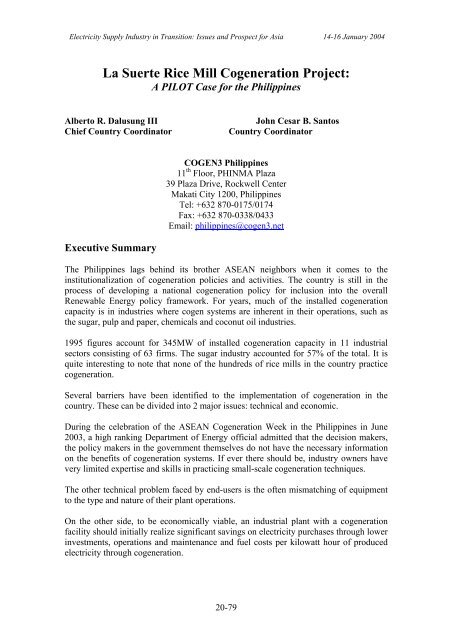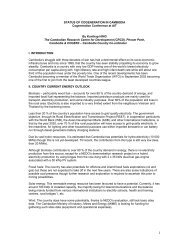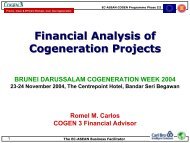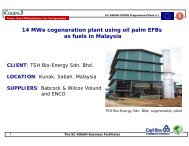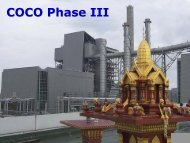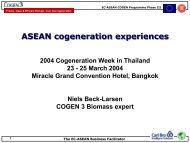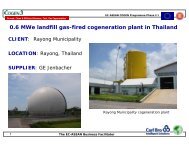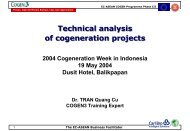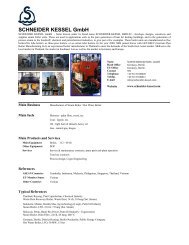La Suerte Rice Mill Cogeneration Project - Philippines - cogen 3
La Suerte Rice Mill Cogeneration Project - Philippines - cogen 3
La Suerte Rice Mill Cogeneration Project - Philippines - cogen 3
Create successful ePaper yourself
Turn your PDF publications into a flip-book with our unique Google optimized e-Paper software.
Electricity Supply Industry in Transition: Issues and Prospect for Asia 14-16 January 2004<br />
<strong>La</strong> <strong>Suerte</strong> <strong>Rice</strong> <strong>Mill</strong> <strong>Cogeneration</strong> <strong>Project</strong>:<br />
A PILOT Case for the <strong>Philippines</strong><br />
Alberto R. Dalusung III John Cesar B. Santos<br />
Chief Country Coordinator Country Coordinator<br />
Executive Summary<br />
COGEN3 <strong>Philippines</strong><br />
11 th Floor, PHINMA Plaza<br />
39 Plaza Drive, Rockwell Center<br />
Makati City 1200, <strong>Philippines</strong><br />
Tel: +632 870-0175/0174<br />
Fax: +632 870-0338/0433<br />
Email: philippines@<strong>cogen</strong>3.net<br />
The <strong>Philippines</strong> lags behind its brother ASEAN neighbors when it comes to the<br />
institutionalization of <strong>cogen</strong>eration policies and activities. The country is still in the<br />
process of developing a national <strong>cogen</strong>eration policy for inclusion into the overall<br />
Renewable Energy policy framework. For years, much of the installed <strong>cogen</strong>eration<br />
capacity is in industries where <strong>cogen</strong> systems are inherent in their operations, such as<br />
the sugar, pulp and paper, chemicals and coconut oil industries.<br />
1995 figures account for 345MW of installed <strong>cogen</strong>eration capacity in 11 industrial<br />
sectors consisting of 63 firms. The sugar industry accounted for 57% of the total. It is<br />
quite interesting to note that none of the hundreds of rice mills in the country practice<br />
<strong>cogen</strong>eration.<br />
Several barriers have been identified to the implementation of <strong>cogen</strong>eration in the<br />
country. These can be divided into 2 major issues: technical and economic.<br />
During the celebration of the ASEAN <strong>Cogeneration</strong> Week in the <strong>Philippines</strong> in June<br />
2003, a high ranking Department of Energy official admitted that the decision makers,<br />
the policy makers in the government themselves do not have the necessary information<br />
on the benefits of <strong>cogen</strong>eration systems. If ever there should be, industry owners have<br />
very limited expertise and skills in practicing small-scale <strong>cogen</strong>eration techniques.<br />
The other technical problem faced by end-users is the often mismatching of equipment<br />
to the type and nature of their plant operations.<br />
On the other side, to be economically viable, an industrial plant with a <strong>cogen</strong>eration<br />
facility should initially realize significant savings on electricity purchases through lower<br />
investments, operations and maintenance and fuel costs per kilowatt hour of produced<br />
electricity through <strong>cogen</strong>eration.<br />
20-79
Beyond electricity cost considerations, investors and end-users are not attracted on the<br />
very high cost of financing <strong>cogen</strong>eration projects adding to it, the considerably longterm<br />
returns on capital investments. At some point in time, energy prices may dictate<br />
the viability of <strong>cogen</strong> plants.<br />
Company owners are also divided whether to indeed “go” <strong>cogen</strong> or to compete with<br />
other investment opportunities and priorities of the plant. A classic case in the<br />
<strong>Philippines</strong> is the CORFARM <strong>Project</strong> which has always been part of the adjudication<br />
procedures of the EC-ASEAN COGEN Programme each time it launches its Call for<br />
Full Scale Demonstration <strong>Project</strong>s or FSDPs. CORFARM normally rates high in scores<br />
but somewhere along the way, the project always FAILS to materialize because of the<br />
indecisiveness of the plant owners to invest its resources on plant expansions rather than<br />
in <strong>cogen</strong>eration technologies, primarily because going <strong>cogen</strong> is just not in line with<br />
corporate objectives of industrial expansion.<br />
Finally, and this is indeed a difficult barrier to hurdle: the non-existence of a successful<br />
<strong>cogen</strong>eration plant in the <strong>Philippines</strong> dampens the mood of potential projects. There is<br />
this inherent trait in us Filipinos that unless we see something working well within the<br />
country’s system, investors, mostly industry owners will not dare take the risk into a<br />
new venture.<br />
But just as there is but ONE (1) successful <strong>cogen</strong>eration venture in the country, then<br />
everything comes into place.<br />
Several measures have been floated as possible means to overcome the barriers just<br />
presented. Among these are:<br />
1) the imminent restructuring of the power industry and the privatization of the<br />
national power utility; and,<br />
2) the perceived state of the power industry in the next 5 years.<br />
Power sector reform has opened opportunities for the development of<br />
<strong>cogen</strong>eration. Our development policy recognizes that adequate power<br />
supply is one of the pre-requisites for sustained economic growth. Power<br />
sector restructuring will open the industry to private investors. Thus the<br />
participation of the private sector in the country’s power expansion program<br />
is urgent and lack of generation capacity may lead to widespread load<br />
shedding, particularly for industries.<br />
3) Private-government sector collaboration is also seen as crucial to advance<br />
renewable energy development, and for that matter, <strong>cogen</strong>eration, in the<br />
<strong>Philippines</strong>. Enhanced non-fiscal and financial incentive packages including:<br />
a) preferential utilization of RE for power generation;<br />
b) 10-year income tax holiday;<br />
c) duty-free importation of machinery and equipment;<br />
d) tax credit on domestic capital equipment; and,<br />
e) special realty tax rates.<br />
20-80
The challenge really now is for <strong>cogen</strong>eration facilities to operate efficiently to produce<br />
electricity (and steam) at a cost that can compete in the open market through upgrade<br />
processes and equipment as well as purchase of modern yet proven technology.<br />
The resurgence of interests for <strong>cogen</strong>eration projects in the <strong>Philippines</strong> showcases the<br />
need for a better and more efficient electricity system in energy-intensive industries.<br />
The <strong>La</strong> <strong>Suerte</strong> <strong>Rice</strong> <strong>Mill</strong> <strong>Cogeneration</strong> <strong>Project</strong>, once it gets on stream by 2004 will pave<br />
the way for succeeding projects in the coming years. We only need a single and<br />
successful <strong>cogen</strong>eration project, just one (1) and the country will definitely follow its<br />
other ASEAN neighbors in the implementation of a more reliable and stable supply of<br />
electric power to its thriving industrial sector.<br />
I. Introduction<br />
For the planning period up to the year 2012, the <strong>Philippines</strong> energy sector reinforces the<br />
macroeconomic goals of the current administration to promote balanced economic<br />
growth, a market-based energy industry and poverty alleviation.<br />
These projections are based on continued economic recovery and robust expansion in<br />
investments and exports as the economy benefits from greater renewed confidence and<br />
sustained macro economic stability as well as measures to improve governance and the<br />
competitiveness of major industrial sectors, energy included.<br />
Investment demand will be driven by continued strong growth in infrastructure<br />
developments in the power sector.<br />
Year-end GDP in 2003 was expected to reach Php1.1 trillion (roughly US$200 billion)<br />
with a similarly optimistic growth rate posted at 5.6%.<br />
Key planning parameters used in the last economic exercise by the <strong>Philippines</strong>’ National<br />
Economic and Development Authority (NEDA) expects that the country will continue<br />
to register positive growth rates from last year onwards to 2007, posting a high of 5.8%<br />
by end-2007.<br />
Key Key Planning Planning Parameters<br />
2002 2003 2007<br />
GNP (Billion Pesos) 1,104.1 1,166.6 1,493.2<br />
GDP (Billion Pesos) 1,034.1 1,091.1 1,387.1<br />
GDP Growth Rate (%) 4.5 5.5 5.8<br />
Population (<strong>Mill</strong>ion) 79.6 81.2 87.4<br />
GDP/Capita (Php Php) ) 12,989.6 13,438.8 15,867.1<br />
Source: Philippine Energy Plan, 2003-2012<br />
20-81
The performance during the last 5 years of the energy market complement’s the<br />
government’s policy to reduce dependence on conventional fuel as much as imported<br />
energy. Oil based facilities decreased by 15.2% from 1997 to 2001, owing to the<br />
retirement of oil-based power plants in the islands of Luzon and Visayas. Generation by<br />
hydro on the other hand increased by 4%, geothermal by 9.6% and natural gas, by a<br />
whopping 190%. The significant increase in generation from natural gas is due to the<br />
commissioning of the Malampaya Deep Water Gas-to-Power <strong>Project</strong> in October 16,<br />
2001, with the initial delivery of gas to the Sta. Rita power plant off the coast of<br />
Tabangao, in Batangas province. Coal-fired generation also increased due to the<br />
commissioning of three (3) power plants with a combined capacity of 2,363MW<br />
covering the period 1998 to 2000.<br />
Currently, the focus and current power sector policy and regulations of the Philippine<br />
government encourage indigenous energy production, particularly those with positive<br />
greenhouse gas impacts. Three (3) alternative and clean fuels available in the country<br />
are thus briefly described for this purpose:<br />
Natural Gas<br />
The natural gas industry in the <strong>Philippines</strong> is a very young sector, with its birth only a<br />
couple of years back. This significant development has necessitated the formulation of<br />
policies and the accompanying regulatory framework for the industry, to ensure<br />
competition as well as make the sector more attractive to downstream investments, in<br />
particular.<br />
To effectively encourage private sector investments in the sector, the government has<br />
focused its sights on these measurable targets:<br />
1) the aggressive promotion of natural gas for both power and non power<br />
applications;<br />
2) the establishment of institutional and physical infrastructure;<br />
3) the construction of greenfield power plants or conversion of existing fossil-fired<br />
plans to gas-power;<br />
4) and the promotion of natural gas alternative fuel in the end-use sectors such as in<br />
buildings and residential establishments for cooking.<br />
The gas supply will come mainly from the Malampaya field production, projected to<br />
yield up to 146 billion cubic feet (BCF) until 2007 and another 150 BCF starting 2008.<br />
However, other gas fields (San Antonio, Libertad, Octon, San Martin and Sampaguita)<br />
are also envisioned to contribute to total gas production. For the planning horizon, 1.5<br />
trillion cubic feet is expected to be generated by the gas producing fields.<br />
20-82
Coal<br />
Coal is the second major fuel source for power generation in the country and yet, is also<br />
the largest contributor of particulates, sulfur dioxide (SO2) and carbon dioxide (CO2) to<br />
the environment.<br />
Compliance with the Clean Air Act (CAA) and the higher cost of mitigating equipment<br />
to abate the effects of coal emission remain to be the main challenge faced by the<br />
downstream coal industry. Thus, government has focused its policy and advocacy on the<br />
adoption of Clean Coal Technologies (CCTs) in coal-fed power plants while<br />
maintaining the competitiveness of local coal.<br />
An incentive on the use of CCT in the power and industrial sectors will encourage the<br />
use of this technology, despite being highly capital-intensive.<br />
Biomass<br />
To promote the development of renewable energy technologies, the Philippine<br />
government will focus on meeting the needs for developing a clear, concise and<br />
coherent renewable energy program.<br />
Major part of this effort will be:<br />
1) the promulgation of incentives for biomass projects such as income tax holidays,<br />
tax and duty-free importation of capital equipment and materials, and tax credits<br />
on local equipments;<br />
2) a soon-to-be-restructured power industry will strengthen, accommodate and will<br />
have preferential bias for renewable energy technologies and projects;<br />
3) a market mechanism will be established for renewable energy-based power<br />
plants.<br />
Agenda for Legislation<br />
Obviously, the country still has to put in place a final policy supporting the development<br />
and utilization of renewable energy. Thus, target policy actions for renewable energy<br />
include:<br />
1) a Renewable Energy Bill to be deliberated and hopefully, approved by Congress<br />
within the year;<br />
2) a green pricing mechanism to promote consumer choice of power supply;<br />
3) the allocation of a minimum amount of generation capacity from RE, similar to<br />
what other countries have implemented; and,<br />
4) the provision of financial and fiscal incentives to RE developers and<br />
implementers.<br />
20-83
National <strong>Cogeneration</strong> Policy<br />
The <strong>Philippines</strong> lags behind its brother ASEAN neighbors when it comes to the<br />
institutionalization of <strong>cogen</strong>eration policies and activities.<br />
The country is still in the process of developing a national <strong>cogen</strong>eration policy for<br />
inclusion into the overall Renewable Energy policy framework.<br />
For years, much of the installed <strong>cogen</strong>eration capacity is in industries where <strong>cogen</strong><br />
systems are inherent in their operations, such as the sugar, pulp and paper, chemicals<br />
and coconut oil industries.<br />
1995 figures account for 345MW of installed <strong>cogen</strong>eration capacity in 11 industrial<br />
sectors consisting of 63 firms. The sugar industry accounted for 57% of the total. It is<br />
quite interesting to note that none of the hundreds of rice mills in the country practice<br />
<strong>cogen</strong>eration.<br />
Barriers to Implementation<br />
Several barriers have been identified to the implementation of <strong>cogen</strong>eration in the<br />
country. These can be divided into 2 major issues: technical and economic.<br />
During the celebration of the ASEAN <strong>Cogeneration</strong> Week in the <strong>Philippines</strong> in June<br />
2003, a high ranking Department of Energy official admitted that the decision makers,<br />
the policy makers in the government themselves do not have the necessary information<br />
on the benefits of <strong>cogen</strong>eration systems. If ever there should be, industry owners have<br />
very limited expertise and skills in practicing small-scale <strong>cogen</strong>eration techniques.<br />
The other technical problem faced by end-users is the often mismatching of equipment<br />
to the type and nature of their plant operations.<br />
On the other side, to be economically viable, an industrial plant with a <strong>cogen</strong>eration<br />
facility should initially realize significant savings on electricity purchases through lower<br />
investments, operations and maintenance and fuel costs per kilowatt hour of produced<br />
electricity through <strong>cogen</strong>eration.<br />
Beyond electricity cost considerations, investors and end-users are not attracted on the<br />
very high cost of financing <strong>cogen</strong>eration projects adding to it, the considerably longterm<br />
returns on capital investments. At some point in time, energy prices may dictate<br />
the viability of <strong>cogen</strong> plants.<br />
Company owners are also divided whether to indeed “go” <strong>cogen</strong> or to compete with<br />
other investment opportunities and priorities of the plant. A classic case in the<br />
<strong>Philippines</strong> is the CORFARM <strong>Project</strong> which has always been part of the adjudication<br />
procedures of the EC-ASEAN COGEN Programme each time it launches its Call for<br />
Full Scale Demonstration <strong>Project</strong>s or FSDPs. CORFARM normally rates high in scores<br />
but somewhere along the way, the project always FAILS to materialize because of the<br />
indecisiveness of the plant owners to invest its resources on plant expansions rather than<br />
20-84
in <strong>cogen</strong>eration technologies, primarily because going <strong>cogen</strong> is just not in line with<br />
corporate objectives of industrial expansion.<br />
Finally, and this is indeed a difficult barrier to hurdle: the non-existence of a successful<br />
<strong>cogen</strong>eration plant in the <strong>Philippines</strong> dampens the mood of potential projects. There is<br />
this inherent trait in us Filipinos that unless we see something working well within the<br />
country’s system, investors, mostly industry owners will not dare take the risk into a<br />
new venture.<br />
But just as there is but ONE (1) successful <strong>cogen</strong>eration venture in the country, then<br />
everything comes into place.<br />
Measures to Remove Barriers<br />
Several measures have been floated as possible means to overcome the barriers just<br />
presented. Among these are:<br />
3) the up and coming restructuring of the power industry and the privatization of<br />
the national power utility; and,<br />
4) the perceived state of the power industry in the next 5 years.<br />
Power sector reform has opened opportunities for the development of<br />
<strong>cogen</strong>eration. Our development policy recognizes that adequate power<br />
supply is one of the pre-requisites for sustained economic growth. Power<br />
sector restructuring will open the industry to private investors. Thus the<br />
participation of the private sector in the country’s power expansion program<br />
is urgent and lack of generation capacity may lead to widespread load<br />
shedding, particularly for industries.<br />
4) Private-government sector collaboration is also seen as crucial to advance<br />
renewable energy development, and for that matter, <strong>cogen</strong>eration, in the<br />
<strong>Philippines</strong>. Enhanced non-fiscal and financial incentive packages including:<br />
a) preferential utilization of RE for power generation;<br />
b) 10-year income tax holiday;<br />
c) duty-free importation of machinery and equipment;<br />
d) tax credit on domestic capital equipment; and,<br />
e) special realty tax rates.<br />
The challenge really now is for <strong>cogen</strong>eration facilities to operate efficiently to produce<br />
electricity (and steam) at a cost that can compete in the open market through upgrade<br />
processes and equipment as well as purchase of modern yet proven technology.<br />
II. The <strong>La</strong> <strong>Suerte</strong> <strong>Rice</strong> <strong>Mill</strong><br />
The <strong>La</strong> <strong>Suerte</strong> (Spanish literal term for “good luck”) <strong>Rice</strong> <strong>Mill</strong> is the only <strong>cogen</strong>eration<br />
project in the <strong>Philippines</strong> that was granted as one of the Full Scale Demonstration<br />
<strong>Project</strong>s (FSDPs) for the third phase of the EC-ASEAN Cogen3 Programme.<br />
20-85
The <strong>La</strong> <strong>Suerte</strong> <strong>Rice</strong> <strong>Mill</strong> (LSRM) is located 600 kilometers north of the city of Metro<br />
Manila, along the national road in San Manuel, Isabela Province. It is about 85<br />
kilometers from the nearest airport of the nearby province of Cagayan. From the airport,<br />
a land trip over mainly good roads will pass through several rice-producing towns with<br />
the trip taking at least 90 minutes during normal traffic and road conditions.<br />
LSRM’s business is built around the production of premium quality milled rice. One of<br />
its popular brands, “Sterling” has been known in the rice industry for its consistent<br />
quality. <strong>La</strong> <strong>Suerte</strong>’s market knowledge and network are the keys to its continued sales<br />
growth and brand recognition.<br />
While some researchers have pointed to the decline of the local rice industry, this is not<br />
reflected in the general prosperity and growth of rice millers in the Isabela province.<br />
The province hosts the largest and most modern rice mills in the country. Three (3)<br />
other rice mills are seriously considering the installation of similar <strong>cogen</strong>eration<br />
systems. These include: (i) Valiant <strong>Rice</strong> <strong>Mill</strong>; (ii) Cauayan Grains Inc.; and, (iii) Golden<br />
Season <strong>Rice</strong> <strong>Mill</strong>.<br />
Corn is also a product of the province of Isabela. Many of the large rice mills in the area<br />
are involved in the corn industry. <strong>La</strong> <strong>Suerte</strong> has identified a seasonal market for corndrying,<br />
which is about three (3) months of the year. There is a current lack of quality<br />
grain drying facilities in the province. Cauayan Grains Inc. is one of the largest corn<br />
milling companies in the <strong>Philippines</strong>. Like <strong>La</strong> <strong>Suerte</strong>, it is expanding and modernizing<br />
its operations. It has prioritized the installation of new silos and is closely monitoring<br />
the LSRM <strong>Cogeneration</strong> <strong>Project</strong> as in intends to replicate the same.<br />
All of these rice mills use essentially the same milling equipment provided by a local<br />
agri-industrial company based in Manila. Further, the owners of these rice mills have<br />
blood relations and have a history of following the successful project implementation<br />
lead of any one of them, incidentally, through the services of Padiscor, the Manila-based<br />
agri-industrial firm.<br />
The Pasig Agricultural Development and Industrial Supply Corporation or Padiscor,<br />
serves as a primary technical advisor of <strong>La</strong> <strong>Suerte</strong>, aside from supplying its major<br />
milling equipment. Padiscor is recognized in the country for its long experience and<br />
expertise in the rice milling industry as a manufacturer of equipment and a keen<br />
follower of trends in post-harvest technology and rice mill operations. The company is<br />
also a holder of a patent on a rice husk furnace which has been used primarily for grain<br />
dryers.<br />
LSRM Operations<br />
Demand for <strong>La</strong> <strong>Suerte</strong> quality rice continued to increase through the years. In 2003, it<br />
built two (2) 1,200 square meter warehouses. Thereafter, LSRM started the construction<br />
20-86
of a modern 6-metric tons per hour rice mill 1 . This mill has 2 parallel lines which can be<br />
independently operated. Each line can produce 3MT of rice per hour.<br />
In July last year, LSRM completed the construction of another parallel line with a 3-ton<br />
per hour output. The new line builds upon the design of the 6-ton rice mill and includes<br />
enhancements that were learned from it. This mill was built for the purpose of allowing<br />
LSRM to operate continuously for 24 hours a day, six days a week during portions of<br />
the peak milling season.<br />
There are three (3) seasons: peak, normal and lean, in the rice mill industry in the<br />
country. The mill is assumed to run at 6MT of rice output per hour capacity during most<br />
of this time. This operating level is 67 percent of its 9MT per hour capacity. This<br />
conservative mode of operation is consistent with the operating philosophy of LSRM.<br />
The same conservatism will continue to be reflected in the company’s selection and<br />
sizing of equipment for the <strong>cogen</strong>eration system.<br />
Thus with 3 milling lines, LSRM can operate any two lines at a time in 12-hour<br />
intervals. The milling equipment can therefore be “rested” and/or maintained or repaired<br />
if necessary, during its “off” interval. Only during a portion of the peak season will the<br />
mill operate at the full capacity of 9MT per hour using the three lines. The third milling<br />
line was inaugurated in October last year.<br />
LSRM’s operation is supported by a fleet of 35 units of tractor-trailers, 2 and 20-tonner<br />
and 10-tonner trucks. LSRM controls and optimizes the movement of its stocks from<br />
paddy sources to its product markets. The movement of stocks within the premises is<br />
handled by a fleet of forklifts and front-end loaders. This will soon be supplemented<br />
with the construction of the silos and related materials handling equipment.<br />
Electrical Supply and Demand<br />
LSRM, together with Green Harvest <strong>Rice</strong> <strong>Mill</strong>, a nearby smaller rice mill also owned by<br />
the same family, depend on various units of diesel generating sets for critical loads. The<br />
electric cooperative, Isabela Electric Cooperative II or ISELCO2, does not have good<br />
voltage stability, particularly in late afternoons and on to the evening. At this time of<br />
day, voltage dips to about 200 volts or less from a nominal voltage of 240.<br />
Specific diesel gensets are assigned to each critical load. For example, to serve LSRM’s<br />
two parallel milling lines, they alternate the use of two units of 750 kVA gensets on a<br />
daily basis. They use the grid supply for the dehusking stage, office and residential<br />
loads and security lighting.<br />
<strong>Mill</strong>ing and Marketing Operations<br />
1 Mr. Jeff Mestdagh of Vyncke Malaysia and Bangkok-based EC-ASEAN COGEN experts remarked that<br />
LSRM is the cleanest rice mill they have ever seen. LSRM management is conscious of the positive<br />
impact of clean work areas and well-designed tasks on labor productivity.<br />
2 Each of these can transport 800 bags of 50 kg. each for a total payload of 40MT. Current schedules<br />
show that at least 5 of these trucks are dispatched daily for wholesale buyers in Metro Manila. LSRM<br />
reconditions its own trucks indicating its competence in restoring/repairing equipment.<br />
20-87
LSRM currently operates 300 days a year, typically 12 to 14 hours a day, 6 days a week.<br />
However, milling hours s dictated by market demand. <strong>Mill</strong>ing hours during the peak<br />
season may stretch to 16 hours a day. <strong>La</strong>tely, LSRM had to procure no less than 23,000<br />
tons of paddy per season. The paddy are placed in bags, stored in the warehouse, and<br />
classified as to variety and quality. Majority of the supply comes from traders all over<br />
the rice-producing province and its neighboring regions as well. They also maintain<br />
landed farmers around the town of San Manuel by financing the production inputs. <strong>La</strong><br />
<strong>Suerte</strong> only buys specific rice varieties of sufficient quality that meets its standard.<br />
LSRM markets 90 percent of its rice mostly in Metro Manila. It directly supplies major<br />
rice wholesalers and caters to some institutional buyers in Metro Manila. <strong>Rice</strong> operation<br />
statistics showed that <strong>La</strong> <strong>Suerte</strong> sells an average of 15,000 tons of various graded rice<br />
per season. With the recent mill expansion, LSRM sees a continued growth and sharp<br />
increases in production and sales. As it expands, it faces several challenges that a<br />
<strong>cogen</strong>eration system is designed to address. These challenges are:<br />
Daily voltage fluctuation and frequent power outages in the San Manuel<br />
town. LSRM has so far handled this problem by operating several diesel<br />
generator sets to serve critical loads. However, diesel gensets require<br />
frequent maintenance and are more costly to operate. 3 Diesel gensets<br />
have also limited life span, necessitating constant sourcing of units to<br />
meet the mill requirements. 4<br />
Increasing cost of grid electricity and diesel fuel.<br />
<strong>Rice</strong> husk disposal.<br />
Need to provide steam and electric power to a new higher-capacity grain<br />
dryer.<br />
III. The <strong>La</strong> <strong>Suerte</strong> <strong>Rice</strong> <strong>Mill</strong> <strong>Cogeneration</strong> <strong>Project</strong><br />
<strong>La</strong> <strong>Suerte</strong> <strong>Rice</strong> <strong>Mill</strong> is now considering the implementation of a <strong>cogen</strong>eration project<br />
using its by-product rice husk as fuel. The project is expected to bring the following<br />
benefits:<br />
Improve the quality and reliability of electric power supply to the entire<br />
rice milling operation. Now the rice mill operates several diesel-fired<br />
gensets to meet its power requirements. The electric cooperative serving<br />
the area cannot maintain stable voltage and electric power service<br />
interruptions are frequent.<br />
Lower the cost of power and rice husk disposal cost.<br />
3 <strong>La</strong>st year, fuel cost alone accounted for nearly Php5 million (close to US$100,000.00) With the new rice<br />
milling line, longer hours of operation, and operation of the large Cimbria grain dryer, the fuel<br />
consumption and cost will increase proportionately. This can be quite expensive without an alternative<br />
source of power.<br />
4 The rice millers in Isabela have become “experts” in sourcing diesel gensets. However, long term<br />
growth can only be attained with having a stable power supply at reasonable cost. This project addresses<br />
this need while providing a host of benefits.<br />
20-88
Meet the new demand for power and steam with the ongoing mill<br />
expansion.<br />
Potentially introduce a new revenue stream from the sale of rice husk<br />
ash.<br />
Potentially introduce another revenue stream from the sale of carbon<br />
credits. Specifically, the project will attempt to qualify for clean<br />
development mechanism (CDM) credits and/or bilateral initiatives at<br />
carbon credits.<br />
LSRM’s proposed project definitely meets the stated objectives of the government’s<br />
policy on projects with positive greenhouse gas impacts. The project considers the<br />
implementation of a modern rice husk heat and power system with an electric power<br />
output of 1MW and process steam supply of 1.62 metric tons per hour (at 110 degrees<br />
Celsius). The power output will displace current onsite generation from diesel gensets<br />
and power purchases from the electric cooperative. The steam output will provide the<br />
requirements of a new grain dryer which is part of the proposed installation.<br />
The rice milling industry has become more complex with the entry of significant<br />
amounts of imported rice into the country. LSRM is well prepared to meet the challenge<br />
head-on. It has a modern rice mill with the ability to process various grades of paddy<br />
into good quality rice. Thus, it can bring in relatively cheap rice from countries such as<br />
Vietnam, “polish” this into higher quality rice and blend it with local varieties to arrive<br />
at a mix of texture, taste and body that the local market favors.<br />
LSRM has been operating successfully under this new market. It has grown<br />
continuously as evidenced by the expansion and modernization of its milling operations.<br />
It operates year-round with an estimated 300 operating days. It has a 6-month peak<br />
period during the rainy season beginning June and a 4-month lean period during the dry<br />
season. Current operations vary from 14 hours daily during the peak months down to 12<br />
hours daily during the lean months.<br />
However, LSRM has been constructing a new line of rice polishing with a capacity of<br />
3MT per hour. This adds 50 percent to the current effective milling capacity of 6MT per<br />
hour, bringing total milling capacity to 9MT per hour. With this expansion, LSRM will<br />
need additional energy supply. The total husk produced will also significantly increase,<br />
thereby worsening an already tedious husk disposal problem.<br />
Waste Generation<br />
LSRM estimates that 24 percent of the paddy input is composed of rice husk. The husk<br />
does not have commercial value in the province of Isabela, although it is used as an<br />
agricultural soil filler to increase air capacity. LSRM transports the rice husk to these<br />
relatively small users at no cost to them. The bulk of the rice husk output will need to be<br />
disposed of a major problem for large rice mills.<br />
Given the 6MT per hour rice output and 300 operating days annually, the yearly rice<br />
output is 699,000 cavans (or 50 kilogram bags). Under this scenario, the annual husk<br />
available is 2.27MT per hour or a total of 12,918MT.<br />
20-89
The energy requirement of LSRM consists mainly of electric power for driving the<br />
motors and process heat for the grain dryer. The estimated power requirement of the<br />
LSRM mill is about 60 kWh/tones of paddy input. This estimate considers other power<br />
loads within the LSRM compound such as security lighting, two residences, the<br />
administration office, and the power load of the Suncue 5 grain dryer (104.1kW).<br />
The boiler to be used, from Vyncke NV Belgium, is rated at a maximum of 3.2MT per<br />
hour rice husk input. The simultaneous operation of all three milling lines (at 9MT 6 rice<br />
output per hour) will produce enough rice husk to attain the full capacity of the boiler.<br />
However, actual operation envisions a 2.27MT per hour or about 71 percent of capacity.<br />
Vyncke has assured that the boiler will run well under this operating condition.<br />
The internal waste generation is enough to support the operating schedule of the<br />
<strong>cogen</strong>eration system. However, there is some provision for greater output with the<br />
availability of more rice husk, either from additional internal capacity or by<br />
supplemental rice husk from nearby rice mills.<br />
Selection of the <strong>Cogeneration</strong> Equipment<br />
The key technical issue in the project is the selection of boiler supplier. While various<br />
technologies exist, the proponents, with the assistance of the EC-ASEAN COGEN3<br />
Programme, focused more on the credibility and track record of the boiler manufacturer.<br />
Several manufacturers were contacted but only two responded to provide technical<br />
information. These were: Vyncke N.V. of Belgium through its regional office in Kuala<br />
Lumpur, Malaysia, and Alstom of France through their Philippine office in Manila.<br />
Alstom is more of a turbine supplier but because of their size, they have various<br />
arrangements with affiliate companies in the boiler side. Vyncke’s proposal included a<br />
quotation for the steam turbine and ancillary systems by Jebsen & Jessen Process<br />
Engineering Sdn. Bhd, an authorized dealer of KKK steam turbines of Germany.<br />
Vyncke N.V.<br />
Vyncke is well known in ASEAN and has several references, including the Bang Heng<br />
Bee rice husk-fired <strong>cogen</strong>eration project in Malaysia. The Bang Heng Bee boiler is<br />
about the same size (10 versus 12MT steam per hour) as the one envisioned for the<br />
LSRM <strong>cogen</strong>eration project. The EC-ASEAN COGEN Phase II Programme supported<br />
this Malaysian project as an FSDP and it has been well in operation for 5 years with no<br />
technical problem. During a recent visit of COGEN3 Philippine country coordinators to<br />
the plant, the owners/managers disclosed their expansion plans and decision to add<br />
another boiler by Vyncke but at a much larger scale.<br />
In the end, the proposal from Vyncke was seen by the LSRM management as more<br />
credible than that of Alstom. Likewise, the financial analysis prepared for the project<br />
5<br />
This is a relatively small oil-fired grain dryer that is built into the design of the rice mill. It cannot be<br />
stopped even with the installation of the new Cimbria dryer.<br />
6<br />
The calculation is as follows: 9MT/hr x 1.5MT paddy/MT rice x 24% rice husk/paddy = 3.24MT rice<br />
husk/hour.<br />
20-90
showed the significant potential of ash sales to the project returns. This can only be<br />
surely realized using Vyncke’s proven technology.<br />
Boiler Steam Pressure<br />
The boiler steam pressure is a major determinant of efficiency and power output of the<br />
<strong>cogen</strong>eration system. Generally, higher steam pressure is desirable because they enable<br />
greater energy extraction and higher efficiencies. However, high steam pressures may<br />
cost significantly more, may require more stringent water purity specifications, and may<br />
need much more qualified staff to operate and maintain.<br />
The boiler steam pressure of 30 bar is similar for both Vyncke and Alstom. This<br />
pressure is appropriate for steam cycle systems of the size contemplated.<br />
Selection of turbine supplier<br />
Steam turbines transform available heat in the steam into kinetic energy and utilize<br />
steam velocity to induce torque upon a rotor. With the choice of Vyncke as boiler<br />
supplier, Jebsen & Jessen’s proposal was found to be most advantageous given their<br />
previous experience of working together. Both companies are also based in Malaysia,<br />
which simplified communications, particularly during the design stages.<br />
Basic system configuration of rice husk-fired power plant<br />
The proposed system configuration/heat balance diagram as submitted By Jebsen &<br />
Jessen is shown below. Since J&J is the source of this diagram, it only shows the<br />
inclusions in J&J’s scope of supply.<br />
The typical “boiler” will fall within the scope of Vyncke N.V. while the grain dryer will<br />
be sourced from Padiscor. Note that the proposed grain dryer shall be connected to the<br />
process steam header in this diagram. The grain dryer is an integral part of the<br />
<strong>cogen</strong>eration system because it performs the function of a condenser in a typical steam<br />
cycle power plant.<br />
Air-cooled condensers are also to be used to condense the steam not passing through the<br />
grain dryer. Air-cooled condensers can be made locally with engineering drawings<br />
supplied by Vyncke. The details of this arrangement are still being worked out by<br />
Vyncke and the LSRM management.<br />
The major components are:<br />
Vyncke boiler system (Type JNO-HD-CLC) producing 12MT per hour of<br />
superheated steam at 30 bar and 300 degrees Celsius 7 and ancillary systems<br />
including the following:<br />
<strong>Rice</strong> husk fuel system<br />
Feed water system<br />
7 Although the steam turbine needs only 25 bar steam pressure, an allowance of 10 percent for boiler<br />
aging and an additional 2 bar for steam distribution system losses were made to assure consistent output<br />
for the life of the power plant.<br />
20-91
Cooling system<br />
Ash handling system<br />
Pollution control equipment<br />
KKK steam turbine (Model AFA4-G4a), turbine auxiliary systems, and ancillary<br />
systems including the following:<br />
Electric generator and auxiliary systems<br />
Process steam header to provide steam for the Cimbria grain dryer<br />
Cimbria grain dryer, silos and related equipment<br />
Raw water is taken from the river and is treated in the water treatment system. A<br />
simple water softening system is required to prevent scaling and corrosion within<br />
the boiler. Some chemicals are added to improve the quality of water before being<br />
fed into the boiler. The make-up water requirement of the boiler is estimated at 500<br />
liters per hour. A cooling tower system was adjudged not to be ideal given the need<br />
to pump the volume of water required coming from the nearest river source.<br />
However, it is too far to access for a once-through cooling system. Thus, the project<br />
chose to adopt the air-cooled condensers, similar to those employed at the Bang<br />
Heng Bee project.<br />
<strong>Rice</strong> husk is the only fuel used in the boiler. Compared with other solid fuels, rice<br />
husk has very high ash content and is quite abrasive. These qualities make it more<br />
challenging to design rice husk boilers. At maximum capacity, the boiler will need<br />
3.2MT of rice husk per hour.<br />
The boiler generates superheated steam at 30 bar and 300 degrees Celsius. During<br />
this process, ash is continuously evacuated from the boiler and stored. A<br />
programmable logic controller (PLC) provides fully automatic monitoring, process<br />
control, safety control and alarm feedback when necessary, for the boiler system.<br />
The back pressure turbine converts the thermal energy available in the form of<br />
steam into mechanical energy (shaft power) and the generator converts the<br />
mechanical energy into electrical energy.<br />
From the steam turbine, the steam goes to a process steam header where it may be<br />
taken to provide heat to the Cimbria grain dryer. Any remaining steam is condensed<br />
using air-cooled condensers and returned to the boiler, making it a closed system.<br />
The current stock 8 diesel generator sets of LSRM may be used as start-up, stand by<br />
and reserve capacity. LSRM has an internal operating voltage of 240volts and<br />
receives power from the grid at 13.8kVA transformers. The power output of the<br />
<strong>cogen</strong>eration plant will replace all current diesel genset generation and normal<br />
purchases from the electric utility.<br />
8 LSRM has a total of 8 diesel gensets onsite. The 2 largest gensets (of 2 x 750 kVA) are envisioned as<br />
start-up and reserve capacity. All others may be maintained for reserved capacity for their dedicated<br />
loads.<br />
20-92
It should be noted that despite the country’s imminent power sector restructuring as<br />
mandated under the Electric Power Industry Reform Act or EPIRA, which allows<br />
electric generating industries to sell excess power to the grid, no power export to the<br />
ISELCO2 (the electric cooperative which holds the franchise area where <strong>La</strong> <strong>Suerte</strong><br />
is located) is contemplated given the cooperative’s precarious financial status. Based<br />
on information from the National Electrification Administration (NEA), ISELCO2<br />
operated at a loss in 2001. It had a high systems loss of 19.8 percent and overall, its<br />
rating has gone from A to C. Months after a strong typhoon hit the entire region,<br />
ISELCO2 has not fully restored its power supply. This is expected to further<br />
exacerbate its financial difficulties.<br />
The only power market for LSRM’s excess capacity is Green Harvest <strong>Rice</strong> <strong>Mill</strong>,<br />
which is situated just 200 meters away from the former’s premises. The year 2006 is<br />
the scheduled time for retail competition. It is therefore assumed that beginning<br />
2006, LSRM can sell excess power to Green Harvest as allowed by law.<br />
During the shutdown period, electricity is required for maintenance work, office<br />
activities and during start-up. During these periods, LSRM may use its diesel<br />
gensets to provide electric power.<br />
Fuel Source<br />
Unlike many rice husk-fired power projects proposed before 9 , this LSRM<br />
<strong>cogen</strong>eration project will not have any problem with rice husk supply. The proposed<br />
Vyncke boiler will need 3.20MT of rice husk per hour at maximum capacity and<br />
about 2.16MT per hour at the design operating point for this project. This is about<br />
the current level of output of LSRM even without the third milling line.<br />
The rice mill will shift to a 24-hour daily operation with the third line being<br />
switched on and the 2 milling lines running at any one time. Thus, the project can<br />
run 24 hours a day, 6 days a week, 300 days annually from its byproduct rice husk.<br />
Though highly unlikely, the rice husk from Green Harvest may be used when<br />
necessary.<br />
<strong>Rice</strong> husk ash aspects<br />
Since the first rice husk-fired <strong>cogen</strong>eration project supported by the EC-ASEAN<br />
COGEN Phase 3, the programme has been following the trends in worldwide rice<br />
husk ash market. Recent preliminary investigations by COGEN3 staff indicate that<br />
rice husk ash is being used in the steel, cement, fertilizer, refractories, poultry farms,<br />
brick-making, die casting, semi conductors, rubber and oil recycling industries.<br />
Geographically, there is a strong demand for rice husk ash in Japan, North America,<br />
Northern and Southern Europe, Korea, Taiwan, Australia and New Zealand. In<br />
Thailand, it is estimated that the domestic price per ton of rice husk ash is at 1,000<br />
baht (about US$25.00) while the international price ranges from US$100 to US$250<br />
per metric ton depending on its quality.<br />
9 This includes a 40-MW rice husk power plant in San Miguel, Bulacan (in the Central Luzon region) by<br />
Cypress Energy of the United States and a smaller 20-MW rice husk power plant by Phinfra-Zurn. Both<br />
will source their fuel from several rice mills in at least 2 nearby provinces.<br />
20-93
COGEN3 and Vyncke are willing to assist LSRM to identify potential marketing<br />
channels for selling rice husk ash in the future. Vyncke has informed LSRM of its<br />
own studies into the rice husk ash market and its willingness to share such<br />
information.<br />
Fuel Requirements, Handling and Storage<br />
The fuel specifications (expressed in wet basis) for the Vyncke boiler are as follows:<br />
<strong>Rice</strong> husks with nominal moisture content of 12 percent and maximum moisture<br />
content of 15 percent.<br />
Nominal lower heating value (LHV) of 3,200 kcal per kilogram with minimal<br />
LHV of 3,000 kcal per kilogram.<br />
Maximum husk dimensions: 30mm x 10mm x 10mm<br />
Granular distribution of husk: 95 percent coarse content (>1mm) by weight. 5<br />
percent fines content (1,100 degrees Celsius, 1,500 degrees Celsius nominal.<br />
Since the rice husk will be internally generated, its handling and storage maybe<br />
adequately provided by current equipment and storage areas. In fact, the<br />
consumption of rice husk internally will reduce the internal requirement for husk<br />
storage.<br />
An alternative way 10 to store the rice husk is open storage in conical shape to<br />
prevent the rain from soaking the husk. While rice husk soaked by rain would<br />
absorb large amounts of moisture, it has been observed that the rice husk which are<br />
stored openly in conical form do not absorb much moisture even after some rain.<br />
The storage would consist of a paved flooring on a compacted ground, a couple of<br />
bucket elevators to bring and pour the rice husk to the top of the cone, and a<br />
conveyor to transport the rice husk from the open storage to the husk silos.<br />
The recommended rice husk handling procedure shall follow as stated:<br />
The unloaded husk shall be loaded to the bucket elevator, which in turn will<br />
bring and unload the husk to the top of the conical rice husk storage and to<br />
the conveyor belt.<br />
The rice husk shall then be transported from the open storage to the husk<br />
silos using a conveyor.<br />
Environmental Aspects<br />
The challenge for “clean energy” projects like this <strong>cogen</strong>eration project has always been<br />
to realize financial benefits from their positive environmental impacts. Economists can<br />
10 Information provided by the COGEN3 <strong>Project</strong> Management Unit based at the Asian Institute of<br />
Technology in Bangkok, Thailand. It reflects the results of actual experiences of Thai rice mills.<br />
20-94
compute “positive externalities” but these are far removed from the day-to-day business<br />
realities and decisions that corporate managers face.<br />
However, recent developments in the international and local fronts may soon make this<br />
dream a reality. There has been concerted effort to operationalize the mechanisms to<br />
allow clean energy projects to be paid actual cash for mitigating greenhouse gas (GHG)<br />
emissions.<br />
The most immediate benefit from the project is the disposal of rice hush in an<br />
environmentally-acceptable manner.<br />
<strong>Project</strong> Emissions<br />
The <strong>cogen</strong>eration system’s GHG emissions will be limited to nitrous oxide emission,<br />
which is calculated to be 198MT CO2 equivalent yearly. Thus the project can reduce<br />
GHG emissions by 7,783 MT CO2 equivalent annually.<br />
IV. Status of the <strong>Philippines</strong>’ Commitment to the Kyoto Protocol and<br />
Related Activities<br />
The <strong>Philippines</strong> has completed its GHG emission inventory, assessment of mitigation<br />
plan (via the ALGAS <strong>Project</strong>), vulnerability and adaptation assessment and the National<br />
Action Plan. Thus, the country actually meets the initial requirements for becoming a<br />
CDM host country. It has elaborated its national development and energy plans that<br />
support sustainable development goals. Also, it is restructuring energy industries<br />
towards liberalization and privatization. This has been done for the downstream<br />
petroleum sector. The government is formulating its plan to privatize the state power<br />
utility and restructure the power market.<br />
The Philippine constitution and other laws provide a framework that is consistent with<br />
the CDM. The national priorities focus on poverty alleviation, market-oriented<br />
economic policies and private sector-led development.<br />
The <strong>Philippines</strong> has a variety of renewable energy projects that may qualify for CDM<br />
support. This proposed <strong>cogen</strong>eration project is one example of a potential CDM project.<br />
It will directly result in GHG mitigation and provide sustainable development<br />
opportunities for farmers and other industries in the area.<br />
Some of the following salient elements have to be established to create an environment<br />
supportive for private enterprises:<br />
1. A stable and effectively administered rational system of laws and<br />
regulations is a decisive element in private sector participation. An<br />
inappropriate framework or poor administration will force the economically<br />
and socially efficient private enterprise to enter into informal activities<br />
outside the framework.<br />
2. The timely resolution of strategic issues will demonstrate government’s<br />
seriousness and concern for private enterprise. These may include sensitive<br />
20-95
political issues of cooperation and support from groups most affected such<br />
as employees of the affected enterprise, the management, and the politicians<br />
ultimately responsible for the action taken.<br />
3. The availability of innovative and development-oriented financial<br />
institutions is crucial. Development finance institutions, commercial banks,<br />
merchant banks, or capital markets are not fully equipped to assist private<br />
investors in the energy sector.<br />
4. The government must set clear technical and financial standards, labor laws<br />
and environmental policies and standards.<br />
Value of Carbon Credits<br />
Although there is no formal mechanism that is fully operational, the Clean Development<br />
Mechanism (CDM) is shaping up to have a reasonable chance of being ratified. Current<br />
efforts have also been placed to simplify accreditation of “small-scale” projects (defined<br />
as those with 15 MW capacity and below).<br />
Using the estimated GHG reduction (at 7,783 CO2 equivalent) and a current value of<br />
carbon credits at a range of US$2 to US$5, the LSRM <strong>cogen</strong>eration plant stands to gain<br />
from US$15,566 to US$38,915.00 annually. However, the process of acquiring carbon<br />
credits is new and fraught with uncertainties. Since the project is looking at financing<br />
from the Development Bank of the <strong>Philippines</strong> (DBP), it may be helpful to discuss with<br />
the Bank as they are being supported by the World Bank as a potential future participant<br />
in this process.<br />
V. Social Development and Investment Barrier Removal<br />
The <strong>cogen</strong>eration project will provide several benefits to the community at large within<br />
the province.<br />
Benefits to small farmers<br />
As LSRM expands and modernizes its operations, it gives additional capacity for its<br />
paddy suppliers, composed mainly of families which have been doing business with the<br />
rice mill for several decades. These are growing families and LSRM has grown in size<br />
together with them. LSRM notes the higher landholdings of their traditional paddy<br />
suppliers. This has been a result of their long-term partnership whereby LSRM provides<br />
critical financing of inputs and services during the planting and harvesting periods.<br />
LSRM’s continued growth provides a stable market for the produce of their traditional<br />
paddy suppliers. This has enabled their suppliers not only to increase landholdings but<br />
to provide education to their children and sustenance for their families.<br />
The large capacity of the grain dryer will enable LSRM to buy higher volumes of wet<br />
paddy during the rainy season, thus ensuring a continuous market for the rice production<br />
of their paddy suppliers. LSRM can also afford to pay higher prices for the wet paddy as<br />
they will have an efficient way to remove the moisture. Finally, this steady ability to<br />
20-96
absorb the rice production will help reduce the need for farmers to source their<br />
immediate cash needs from the traditional loan sharks in the community.<br />
Alternate livelihood<br />
LSRM’s vision for its employees is to liberate them from the drudgery of farm work<br />
and its attendant seasonal income. LSRM’s mechanization requires new skills in<br />
operating high-technology equipment. The management has shown willingness to train<br />
people working for them and provide them with good working conditions, continuous<br />
source of income as their operations are year-round and relatively higher salaries and<br />
wages.<br />
Barriers Removal<br />
Biomass <strong>cogen</strong>eration is widely practiced in Thailand and Malaysia. This type of<br />
project has so far eluded the <strong>Philippines</strong> on account of several policy, institutional and<br />
investment barriers.<br />
The actual implementation of the proposed <strong>cogen</strong>eration project will showcase the<br />
positive impacts and practicality of biomass <strong>cogen</strong>eration. This is not only a theoretical<br />
benefit but a real benefit given that at least three other rice mills in the province are<br />
seriously considering replicating this <strong>cogen</strong>eration once its operation is implemented<br />
successfully.<br />
VI. Conclusion<br />
The rice husk-fed power plant is technically feasible to be implement for <strong>La</strong> <strong>Suerte</strong> that:<br />
(i) it produces electricity of 1MW of electric capacity, and (ii) it provides steam for<br />
grain drying at 1.5 bar under the conditions prevailing in LSRM. A boiler with 12MT<br />
steam output per hour at 30 bar and 300 degrees Celsius is more than sufficient for this<br />
requirement.<br />
The financial analysis prepared for the project shows a positive return with a pay-back<br />
by the 7 th year. This positive return is maintained under the worst case scenario.<br />
The project is commercially viable and appropriate for the expansion and modernization<br />
of LSRM. It defines a scheme which is well within the technical and managerial<br />
capability of LSRM management and staff. Being a capital intensive project however,<br />
the implementation should be closely monitored. There should be adequate contractual<br />
definition of the various supplier responsibilities and their linkages among each other.<br />
20-97
ACKNOWLEDGMENT<br />
The authors wish to thank the following organizations for the full support it has been<br />
extending to the EC-ASEAN COGEN3 Programme:<br />
Energy Development Utilization and Foundation Inc. (EDUFI)<br />
Trans-Asia Power Generation Corporation (TA Power)<br />
<strong>Philippines</strong>’ Department of Energy (DOE)<br />
Preferred Energy Inc. (PEI)<br />
<strong>Philippines</strong> Department of Science and Technology (DOST)<br />
Philippine Sugar Technologists Association (Philsutech)<br />
Philippine Sugar <strong>Mill</strong>s Association (PSMA)<br />
Delegation of the European Commission in Manila<br />
20-98


